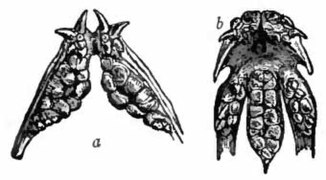Striped sea wolf
| Striped sea wolf | ||||||||||||
|---|---|---|---|---|---|---|---|---|---|---|---|---|

Striped Sea Wolf ( Anarhichas lupus ) |
||||||||||||
| Systematics | ||||||||||||
|
||||||||||||
| Scientific name | ||||||||||||
| Anarhichas lupus | ||||||||||||
| Linnaeus , 1758 |
The striped sea wolf ( Anarhichas lupus ) is a 1.25 to 1.5 meter long marine fish found in the North Sea , around the British Isles , in the Biscay , along the coast of Norway , in the Barents Sea , near Iceland , on the coast of southern Greenland and in the western Atlantic from Labrador , via Newfoundland to Cape Cod in Massachusetts . In the Baltic Sea he is said to live as far as Rügen and Bornholm .
features
Characteristic for the species are 10 to 15 dark stripes that run down from the dorsal fin over the elongated body. The striped sea wolf is mostly gray-green in color. But there are also reddish-brown and black specimens. The teeth are very strong, the teeth are changed in winter.
Way of life
The striped sea wolf lives solitary on the sea floor in rocky habitats, more rarely on sandy or muddy bottoms, at depths of 20 to 500 meters. It feeds mainly on hard-shelled invertebrates such as mussels , sea urchins and crabs.
Striped sea wolves spawn from October through January. The females lay up to 25,000 eggs that are 5 to 6 mm in diameter. The egg ball lying on the sea floor is guarded by the male until the larvae hatch after about two months. The larvae are about one centimeter long when they hatch and live on their yolk sac for another 3 to 4 months. After that, they live pelagic to return to soil life with a length of 5 to 6 centimeters.
use
The striped sea wolf is a popular food fish in Europe . It comes from the cold seas of the northern hemisphere and is only fished as bycatch , so it is not offered at certain times of the year. The fishermen are careful with him because he can bite wildly long after landing. It is considered overfished .
As a whole (and gutted) fish, it is sometimes used for grilling. Because of its coarse appearance, however, the fish is usually traded filleted , sometimes in slices ("carbonate fish"). The fillets or slices are marketed fresh or frozen as kat (t) fish, carbonate fish or under the trade name " loach ". However, it has nothing to do with the protected freshwater fish wolffish . The relatively firm meat is suitable for roasting, poaching and steaming. As a cooked fish, it goes well with classic ingredients such as mustard (sauce) and potatoes. In the kitchen language it is sometimes referred to as Lupo di mare or Loup de mer in German-speaking countries .
See also: Spotted Sea Wolf (is also marketed under the trade name "Loach")
literature
- Bent J. Muus, Jørgen G. Nielsen: The marine fish of Europe in the North Sea, Baltic Sea and Atlantic. Kosmos, Stuttgart 1999, ISBN 3-440-07804-3 .
- Hans Thiele (1953): Comparative morphological studies on the function of the food acquisition apparatus of Anarhichas lupus L. and some Blenniidae. Zoological contributions NF 9 (volume 2/3).
Web links
- Striped Sea Wolf on Fishbase.org (English)



